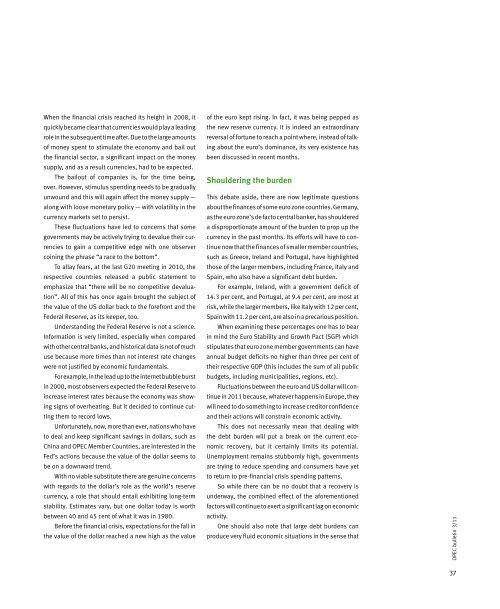OPEC Bulletin January 2009OPEC Bulletin February 2009OPEC ...
OPEC Bulletin January 2009OPEC Bulletin February 2009OPEC ...
OPEC Bulletin January 2009OPEC Bulletin February 2009OPEC ...
You also want an ePaper? Increase the reach of your titles
YUMPU automatically turns print PDFs into web optimized ePapers that Google loves.
When the financial crisis reached its height in 2008, it<br />
quickly became clear that currencies would play a leading<br />
role in the subsequent time after. Due to the large amounts<br />
of money spent to stimulate the economy and bail out<br />
the financial sector, a significant impact on the money<br />
supply, and as a result currencies, had to be expected.<br />
The bailout of companies is, for the time being,<br />
over. However, stimulus spending needs to be gradually<br />
unwound and this will again affect the money supply —<br />
along with loose monetary policy — with volatility in the<br />
currency markets set to persist.<br />
These fluctuations have led to concerns that some<br />
governments may be actively trying to devalue their currencies<br />
to gain a competitive edge with one observer<br />
coining the phrase “a race to the bottom”.<br />
To allay fears, at the last G20 meeting in 2010, the<br />
respective countries released a public statement to<br />
emphasize that “there will be no competitive devaluation”.<br />
All of this has once again brought the subject of<br />
the value of the US dollar back to the forefront and the<br />
Federal Reserve, as its keeper, too.<br />
Understanding the Federal Reserve is not a science.<br />
Information is very limited, especially when compared<br />
with other central banks, and historical data is not of much<br />
use because more times than not interest rate changes<br />
were not justified by economic fundamentals.<br />
For example, in the lead up to the internet bubble burst<br />
in 2000, most observers expected the Federal Reserve to<br />
increase interest rates because the economy was showing<br />
signs of overheating. But it decided to continue cutting<br />
them to record lows.<br />
Unfortunately, now, more than ever, nations who have<br />
to deal and keep significant savings in dollars, such as<br />
China and <strong>OPEC</strong> Member Countries, are interested in the<br />
Fed’s actions because the value of the dollar seems to<br />
be on a downward trend.<br />
With no viable substitute there are genuine concerns<br />
with regards to the dollar’s role as the world’s reserve<br />
currency, a role that should entail exhibiting long-term<br />
stability. Estimates vary, but one dollar today is worth<br />
between 40 and 45 cent of what it was in 1980.<br />
Before the financial crisis, expectations for the fall in<br />
the value of the dollar reached a new high as the value<br />
of the euro kept rising. In fact, it was being pepped as<br />
the new reserve currency. It is indeed an extraordinary<br />
reversal of fortune to reach a point where, instead of talking<br />
about the euro’s dominance, its very existence has<br />
been discussed in recent months.<br />
Shouldering the burden<br />
This debate aside, there are now legitimate questions<br />
about the finances of some euro zone countries. Germany,<br />
as the euro zone’s de facto central banker, has shouldered<br />
a disproportionate amount of the burden to prop up the<br />
currency in the past months. Its efforts will have to continue<br />
now that the finances of smaller member countries,<br />
such as Greece, Ireland and Portugal, have highlighted<br />
those of the larger members, including France, Italy and<br />
Spain, who also have a significant debt burden.<br />
For example, Ireland, with a government deficit of<br />
14.3 per cent, and Portugal, at 9.4 per cent, are most at<br />
risk, while the larger members, like Italy with 12 per cent,<br />
Spain with 11.2 per cent, are also in a precarious position.<br />
When examining these percentages one has to bear<br />
in mind the Euro Stability and Growth Pact (SGP) which<br />
stipulates that euro zone member governments can have<br />
annual budget deficits no higher than three per cent of<br />
their respective GDP (this includes the sum of all public<br />
budgets, including municipalities, regions, etc).<br />
Fluctuations between the euro and US dollar will continue<br />
in 2011 because, whatever happens in Europe, they<br />
will need to do something to increase creditor confidence<br />
and their actions will constrain economic activity.<br />
This does not necessarily mean that dealing with<br />
the debt burden will put a break on the current economic<br />
recovery, but it certainly limits its potential.<br />
Unemployment remains stubbornly high, governments<br />
are trying to reduce spending and consumers have yet<br />
to return to pre-financial crisis spending patterns.<br />
So while there can be no doubt that a recovery is<br />
underway, the combined effect of the aforementioned<br />
factors will continue to exert a significant lag on economic<br />
activity.<br />
One should also note that large debt burdens can<br />
produce very fluid economic situations in the sense that<br />
<strong>OPEC</strong> bulletin 3/11<br />
37

















